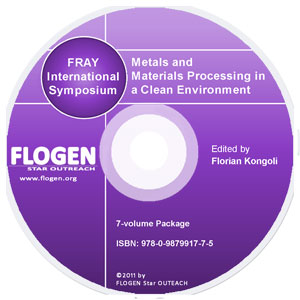
CD shopping page |
2011-Sustainable Industrial Processing Summit
|
| Editors: | Florian K |
| Publisher: | Flogen Star OUTREACH |
| Publication Year: | 2012 |
| Pages: | 764 pages |
| ISBN: | 978-0-9879917-5-1 |
| ISSN: | 2291-1227 (Metals and Materials Processing in a Clean Environment Series) |
Copper Recovery From Black Copper Minerals
Oscar Benavente1; MarÃa Cecilia Hernández1; Yuri Zepeda2; Evelyn Melo1; Luis Ardiles1; SELECT * FROM contact WHERE email_address REGEXP('obenaven@ucn.cl|mhernan@ucn.cl|yzepeda@xstratacopper.cl|emelo@ucn.cl|lardiles@ucn.cl')*********************1UNIVERSIDAD CATOLICA DEL NORTE, Antofagasta, Chile; 2MINERAL LOMAS BAYAS, Antofagasta, Chile;
Type of Paper: Regular
Id Paper: 466
Topic: 14
Abstract:
This article presents the results of evaluating the acid leaching of ores containing black copper, by modifying the redox potential of the leaching solution through the addition of several potential modifiers.Five leaching conditions are evaluated: traditional sulphuric acid medium and 4 with the addition of a potential modifier: ferrous sulfate (FeSO4), white metal (Cu2S), sulfur dioxide (SO2) and ozone (O3). Two methodologies were used for leaching in the laboratory: a bottles test and use of 1m columns. The ore that is leached comes from the Lomas Bayas mining company whose characterization indicates 0,251%CuT and 0,380%Mn. Mineralogical analysis indicates the presence of black copper at a rate exceeding ....The results of the tests in bottles indicate that by decreasing the potential for reducing agents, extraction of copper was achieved in the range of 83.7%, which exceeds by 16.7% the removal obtained in conventional acid leaching. The potential increase (ozone) does not favor the removal of Cu.The extraction percentage of Cu is directly related to the Mn extraction percentage. The ratio of dissolved moles of Mn per dissolved moles of Cu is between 0.5 and 2 for the different agents used.The results of the leaching in columns show that with the white metal and SO2, it is possible to maintain the potential of the solution to values below 450 mV, obtaining the best results of copper extraction, at approximately 60%, which is 18% higher than conventional leaching and an acid consumption in the range of 11 kg/t, over a period of 45 days of leaching.